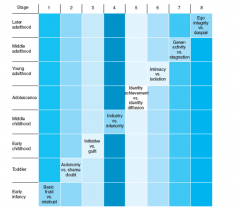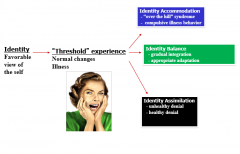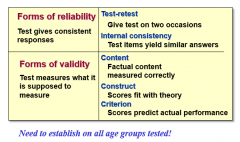![]()
![]()
![]()
Use LEFT and RIGHT arrow keys to navigate between flashcards;
Use UP and DOWN arrow keys to flip the card;
H to show hint;
A reads text to speech;
64 Cards in this Set
- Front
- Back
- 3rd side (hint)
|
Programmed Aging Theory |
Propose the aging and death are programmed into the hard-wiring of all organisms and are therefore part of the genetic code Evidence: life span differences across species, "good gene, bad gene" theory, and replicatove senescence |
|
|
|
"Good genes, bad genes" theory |
evolution has selected for species that are vigorous through the period of optimal sexual reproduction and then are less important once that period has passed |
|
|
|
Replicative senescence |
loss of ability of cells to reproduce cells have a limited number of replications |
|
|
|
Heritability index |
indicates the strength of genetic influence on a characteristic H2 = 2(Rmz-Rdz) Rmz: correlation between monozygotic twins Rdz: correlation between dizygotic twins |
|
|
|
Telomere theory of Programmed aging theory |
loss of telomeres may cause aging, each cell replication reduces the length of telomeres until chromosome tips no longer protected telomeres = end of chromosome that protects genetic material from being lost during replication |
|
|
|
Life span perspective |
Views development as continuous from childhood through old age |
This is an expanded view of development |
|
|
Contextual influences on development |
Life span change is a function of nature and nurture. Incorporates the effects of sex, race, ethnicity, social class, religion, and culture |
This is an expanded view of development |
|
|
Developmental science |
Replacing developmental "psychology" Focus encompasses a broader variety of domains rather than just the psychology of the individual |
An expanded view of development |
|
|
Telomere |
End of chromosome that protects genetics material during replication |
|
|
|
Longevity Gene |
FOXO3A certain SNPs in the FOXO3A gene are associated with longevity |
|
|
|
Random error theories |
Based on the assumption that aging reflects unplanned changes in an organism over time. Cross-linking, free Radical, error Catastrophe |
|
|
|
Cross-linking theory |
Proposes that aging causes deleterious changes in cells off connective tissue Collagen molecules intertwined, causing the molecules to become increasingly more rigid and smaller Results from exposure to certain kinds of sugars Collagen becomes harder, less elastic, and tends to tear or crack (causes skin wrinkles) |
|
|
|
Free radicals |
Atoms with unpaired electrons that are highly reactive; products of metabolism |
|
|
|
Free radical theory |
Free radicals cause destructive changes in cells Mixed data on anti-oxidants, caloric restriction and resveratrol |
|
|
|
Error catastrophe theory |
Mutations lead to deleterious changes Errors in mitochondrial DNA may be a source of harmful changes that cause aging |
|
|
|
Collagen |
Long fibrous protein Strands form a triple helix Makes up much of the connective tissue in the body |
|
|
|
Why would it be harmful for long endurance athletes to take antioxidants? |
Exercise increases metabolism, creating more free radicals. Our bodies naturally regulate antioxidant production, as long as we are eating a relatively healthy diet |
|
|
|
Organismic Model |
Heredity drives the course of development throughout life |
Model of individual-environment interactions |
|
|
Mechanistic Model |
People's behaviour changes gradually over time, shaped by the outside forces that cause them to adapt to their environments |
Model of individual-environment interactions |
|
|
Interactionist Model (Similar to niche picking) |
Not only do genetics and environment interact in complex ways to produce their effects on the individual, but individuals actively shape their own development |
Model of individual-environment interactions |
|
|
Plasticity in development |
The course of development may be altered, depending on the nature of the individual's specific interactions specific interactions in the environment |
|
|
|
Erikson's psychosocial theory |

People develop a series of eight stages as they progress from birth to death Not necessarily linear |
|
|
|
Erikson's psychosocial theory: Identity achievement vs identity diffusion stage |
First emerges in adolescents, but can persist for quite a while if not resolved well. Choose a multitude of different selves, goal is to develop clear sense of identity, good sense of who you are If not resolved => Diffusion; lack of direction, unclear sense of self Basis for later adult stages. impossible to solve next stage if goes unresolved |
|
|
|
Erikson's psychosocial theory: intimacy vs. isolation stage |
Establish fully intimate relationship with another. Intersection of two identities while preserving the sense of self. Need clear sense of self to accomplish this isolation occurs in individuals without a strong sense of identity |
|
|
|
Erikson's psychosocial theory: Generativity vs. Stagnation stage |
Mid-life. Concerns are about the next generation. Often expressed through parenting, but for those that choose not to be parents often put efforts towards teaching, mentoring, productive careers towards others If not resolved, stagnation increase self absorption, rejects younger generation |
|
|
|
Erikson's psychosocial theory: Ego integrity vs Despair stage |
Psychosocial issues related to aging and death, doesn't have to be end of life (terminal illness early in life) Evaluate ones life and accomplishments to verify meaning, look back with acceptance If not resolved, leads to fear and despair, feels death coming too fast to correct unresolved issues |
|
|
|
Piaget's cognitive development theory |
Believed that development involves continuing growth of the individuals knowledge about the world through a set of opposing, complementary processes called assimilation and accommodation |
|
|
|
Schema |
Mental structure we use to understand the world |
|
|
|
Assimilation |

People use their existing schema's as a way to understand world around them. Individuals changes their interpretation of reality to fit schema's |
|
|
|
Accomodation |

When you change your schema in response to new information about the world |
|
|
|
Identity |
Set of schema's that the person hold about the self (Sense of self) Psychologically healthy adults have positive bias, and we assimilate experiences to keep that positive bias |
|
|
|
Identity process theory |

Proposes that identity continues to change in adulthood in a dynamic manner Assumes that people approach their experiences from the vantage point provided by identity |
Psychological model of development in adulthood |
|
|
Identity Assimilation |
The tendency to interpret new experiences in terms of a persons existing identity When people use identity assimilation they tend to resist changing their identities in the face of criticism or discomforting experiences |
|
|
|
Identity Accomodation |
People make changes in their identities in response to experiences that challenge their current views of themselves Must come to grips with weaknesses (with exception of depression), but will produce image that is more in sync with reality |
|
|
|
Identity Balance |
Refers to the dynamic equilibrium that occurs when people tend to view themselves consistently but can make changes when called for by their experiences Assimilation and accommodation are most beneficial when working in tandem |
|
|
|
Multiple Threshold Model |
Proposes that individuals realize they are getting older through a step-wise process as aging-related changes occur (i.e. wrinkles) People are most likely to monitor areas of greatest significance to their identities with great care, while paying less attention to the thresholds that don't mean as much
|
i.e. someone may be preoccupied with the fact that their hair is thinning or turning grey, but less focused on the changes happening o their muscles. someone else may feel the opposite. Psychological model of development in adulthood |
|
|
Selective Compensation with Optimization Model |
Adults attempt to preserve and maximize the abilities that are of central importance and put less effort into maintaining those that are not |
Psychological model of development in adulthood |
|
|
Variable |
Characteristic along which people differ |
|
|
|
Independent variable |
Variable that is manipulated Age is a surrogate variable - it cannot be manipulated (i.e In memory study, age can be surrogate for life experience or brain integrity) |
|
|
|
Dependent variable |
Variable that is observed |
|
|
|
Experimental design |
Manipulation of independent variable Respondents randomly assigned to groups Determine cause and effect |
|
|
|
Quasi-experimental design |
Compare groups on predetermined characteristic Cannot draw cause and effect conclusion Used in most studies of aging |
|
|
|
Why is it, in behavioural studies, we rarely determine cause and effect? |
Because we often cannot manipulate independent variables There will always be a confound, because we cannot ethically do a "proper" experiment |
|
|
|
How do we determine if a finding from a behavioural study experiment was a true effect? |
We must ask the following questions: Was it a good experimental design? and has this been replicated? *We cannot determine cause and effect* |
|
|
|
What are the 3 confounds that effect every behaviour study? |
Age, cohort, and time of measurement |
|
|
|
Confound: Age |
Chronological age measured in years Measurement of change within the individual |
|
|
|
Confound: Cohort |
Period of birth measured in interval time Measurement of the influences relative to history at time of birth |
|
|
|
Confound: Time of measurement |
Date at which testing occurs Measurement of current influences on individuals being tested |
|
|
|
Two age groups studying memory: 20 and 70 years old. Age group is confounded by cohort. What are some examples of cohort confounds? |
Methods used to study i.e. computers, younger age group might be a lot better with computers |
|
|
|
Why can time of measurement be a problem with longitudinal studies?
|
Research methods could become out-dated |
|
|
|
Longitudinal Design |
People are followed repeatedly from one test occasion to another Researchers aim to determine whether participants have changed over time as a result of the aging process Pro: seem to measure age "changes" Con: practice effects, costly CAN ONLY MEASURE AGE CHANGES |
|
|
|
Cross-sectional Design |
Researchers compare groups of people with different ages at one point in time Pro: relatively quick, current theories can be tested Con: results may be due to cohort differences, cannot attribute differences to aging process CAN ONLY MEASURE AGE DIFFERENCES |
|
|
|
Selective Attrition |
People who drop out of a longitudinal study are not necessarily Representative of the sample that was originally tested Drop out due to illness, lack of motivation, death, instability |
|
|
|
What is the problem with selective attrition? |
Data from the study become increasingly skewed as the study wears on |
|
|
|
Sequential research design |
Involves sequence of studies - series of cross sectional designs, repeated Allow inferences to be made about age and historical influences |
|
|
|
Simple Correlational Design |
Relationships are observed among 2 variables as they exist in the world, no manipulation of variables Statistic can range from -1 to +1 Cannot infer cause-effect relationships |
|
|
|
Multivariate Correlational Design |
Involves the analysis of relationships among more than two variables 1. controls for confounds other than age - can evaluate effects of potentially important factors 2. allow investigations of "causality" - paths can actually be drawn from one variable to another 3. provided ways to examine change over time - can use statistical methods that model changes in growth |
|
|
|
Multiple Regression |
A set of predictor variable are defined and used to predict the dependent variable |
|
|
|
Logistic Regression |
Test likelihood of individual receiving a score on a discrete yes-no variable |
|
|
|
Path analysis |
Examine all possible correlations among a set of variables to see if they can be explained by a single model of directional paths |
|
|
|
Structural equation modeling |
Tests path involving latent variables as well as measured variables |
|
|
|
Hierarchical linear modeling |
Growth curves for each individual are examined over the time course of the study |
|
|
|
Ethics (List 5) |
Informed consent - assent Debriefing Suggest resources Right to withdraw Confidentiality of data |
|
|
|
Measurement issues in research: psychometrics |

|
|

